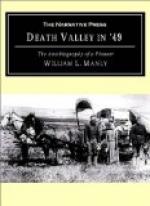About this time we met a odd looking train going east, consisting of five or six Mormons from Salt Lake, all mounted on small Spanish mules. They were dressed in buckskin and moccasins, with long spurs jingling at their heels, the rowels fully four inches long, and each one carried a gun, a pistol and a big knife. They were rough looking fellows with long, matted hair, long beards, old slouch hats and a generally back woods get-up air in every way. They had an extra pack mule, but the baggage and provisions were very light. I had heard much about the Mormons, both at Nauvoo and Salt Lake, and some way or other I could not separate the idea of horse thieves from this party, and I am sure I would not like to meet them if I had a desirable mule that they wanted, or any money, or a good looking wife. We talked with them half an hour or so and then moved on.
We occasionally passed by a grave along the road, and often a small head board would state that the poor unfortunate had died of cholera. Many of these had been torn open by wolves and the blanket encircling the corpse partly pulled away. Our route led a few miles north of Chimney Rock, standing on an elevated point like a tall column, so perfect and regular on all sides, that from our point it looked as if it might be the work of the stone cutters. Some of the party went to see it and reported there was no way to ascend it, and that as far as a man could reach, the rocks were inscribed with the names of visitors and travelers who passed that way.
At Scott’s Bluffs, the bluffs came close to the river, so there was considerable hill climbing to get along, the road in other places finding ample room in the bottom. Here we found a large camp of the Sioux Indians on the bank of a ravine, on both sides of which were some large cottonwood trees. Away up in the large limbs platforms had been made of poles, on which were laid the bodies of their dead, wrapped in blankets and fastened down to the platform by a sort of a network of smaller poles tightly lashed so that they could not be dragged away or disturbed by wild animals. This seemed a strange sort of cemetery, but when we saw the desecrated earth-made graves we felt that perhaps this was the best way, even if it was a savage custom.
These Indians were fair-sized men, and pretty good looking for red men. Some of our men went over to their camp, and some of their youths came down to ours, and when we started on they seemed quite proud that they had learned a little of the English language, but the extent of their knowledge seemed to be a little learned of the ox-drivers, for they would swing their hands at the cattle and cry out “Whoa! haw, g—d d—n.” Whether they knew what was meant, I have my doubts. They seemed pretty well provided for and begged very little, as they are apt to do when they are hard pressed.
We saw also some bands of Pawnee Indians on the move across the prairies. They would hitch a long, light pole on each side of a pony, with the ends dragging behind on the ground, and on a little platform at the hind end the children sat and were dragged along.




